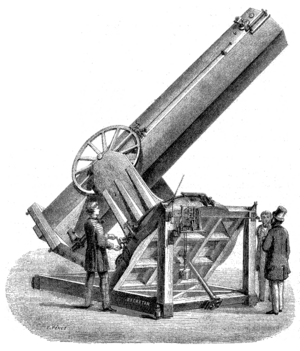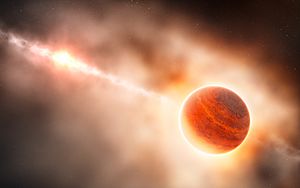Marseille Observatory facts for kids
Quick facts for kids Marseille Observatory |
|||||||
|---|---|---|---|---|---|---|---|
| Organization | Observatoire des Science de l'Univers Institut Pythéas | ||||||
| Location | Marseille, France | ||||||
| Altitude | 40 m (130 ft) | ||||||
|
|||||||

The Marseille Observatory (in French, Observatoire de Marseille) is an astronomical observatory located in Marseille, France. It has a long and interesting history that started way back in the early 1700s.
In 1877, a group of galaxies called Stephan's Quintet was discovered here by the observatory's director, Édouard Stephan. Today, the Marseille Observatory is a research center. It is run by Aix-Marseille University and the French National Center for Scientific Research (CNRS).
The old observatory buildings at Palais Longchamp are a popular place for tourists to visit in Marseille. A planetarium was added there in 2001. You can see cool exhibits like the Foucault glass-mirror telescope. There are also many other items from centuries of studying space.
The Foucault telescope is very important in history. It was one of the first big reflecting telescopes to use a thin layer of metal on a shaped piece of glass as its mirror. Before this, most telescope mirrors were made entirely of metal. It took about 50 more years for silver-coated glass mirrors to become common in astronomy. Later, in the 20th century, scientists started using a special vapor process to coat the glass with silver instead of a liquid solution.
Contents
Early History of the Observatory
The Marseille Observatory first opened in 1701. It was located in Montee des Accoules, which is near Vieux Port in Marseille, France. Antoine Laval was the very first director of the observatory.
Observing the Transit of Venus
In 1761, astronomers at Marseille observed the 1761 transit of Venus. This is when the planet Venus passes directly in front of the Sun. They used a 6-foot-long telescope made by James Short for this important observation. The astronomer Louis Lagrange led these observations.
Jean-Louis Pons and Comet Discoveries
In 1789, Jean-Louis Pons started working at the Marseille Observatory as a doorkeeper. He also began learning about astronomy. By 1801, he had discovered his first comet. Pons became one of the most successful comet discoverers ever. He found 37 comets in total! This was a huge number of all comet discoveries for about 25 years.
Discoveries in the 1800s
Many astronomers at the Marseille Observatory made important discoveries in the 19th century.
More Comet Discoveries
Astronomer Jean-Félix Adolphe Gambart discovered 16 comets from the old observatory. Another famous astronomer who worked there was Benjamin Valz.
Jean-Louis Pons, who started as a doorkeeper, discovered his first comet in 1801. He went on to find 37 more during his career. Many of these were found at the Marseille Observatory.
The Comet Pons-Brook was discovered by Pons in July 1812. It was not seen again until June 1883. It was then seen again in 1953. Some other well-known comets Pons discovered include 7P/Pons–Winnecke, 12P/Pons–Brooks, and 273P/Pons–Gambart.
Pons also discovered comets that later became known by other names. These include Encke's Comet, Comet Crommelin, and Biela's Comet. This happens sometimes because comets are later found to be ones seen before. Or, they might be discovered by more than one person at the same time. Also, some comets are named after the first person to figure out their path, like Halley's Comet.
The Foucault Telescope
Foucault used his 80 cm (about 31.5 inches) silver-on-glass reflecting telescope at Marseille Observatory. This telescope was used from about 1862 until it was retired in 1965. It was a very important design because it was one of the first to use silver-coated glass in a reflecting telescope.
New Buildings and Instruments
In 1863, the Marseille Observatory became a part of the Paris Observatory. This led to a new building being opened in 1864. It was designed by the same architect who designed Notre-Dame de la Garde. The 80 cm Foucault telescope was also installed in this new building at the Palais Longchamp site that year.
Work continued to improve the observatory. By 1866, a Comet Seeker telescope with an 18 cm opening was installed. In 1872, a 25.8 cm (about 10.25 inch) refractor telescope by Merz was added. This Merz telescope was on a special mount that helped it track stars.
The observatory also had instruments and facilities for studying magnetism.
In 1873, the Marseille Observatory announced the discovery of 300 new nebulae. Of these, 75 had their exact positions recorded. This was done by comparing the nebula's location to stars whose positions were already known.
In 1873, the Marseille Observatory became independent from the Paris Observatory again. In 1874, the comet C/1874 H1 was discovered from the observatory.
The 20th Century at the Observatory
The observatory continued its important work into the 20th century.
Observing the Orion Nebula
In 1914, the Orion Nebula was observed using a special tool called a Perot-Fabry interferometer. This tool helps scientists study light in great detail.
New Telescopes and Studies
In 1965, the Foucault 80 cm reflecting telescope was retired after many years of service.
In 1989, a new Marseille telescope was finished at the observatory. It was then sent to the Southern Hemisphere later that year. This telescope is a reflecting telescope with a 36 cm (about 14.2 inch) mirror. It uses a special type of glass-ceramic and is a Richey-Chrétien design.
Starting in 1990, the Marseille Observatory began a study of H alpha (Hα) in the southern part of our galaxy. This study also included observations of the Magellanic Clouds. The 36 cm Marseille telescope at La Silla observatory in the southern hemisphere was used to collect data for this project.
In 1999, the Marseille Observatory published a study. It was about using computer simulations to understand how proto-planets and planetesimals form around a large planetary body. This simulation used a powerful computer system called GRAPE-4.
Marseille Observatory in the 2000s
In 2000, the Marseille Observatory joined with another lab called Laboratoire d'Astrophysique Spatiale. Together, they became the Laboratoire d'Astrophysique de Marseille (LAM). This was part of a larger group called Observatoire Astronomique Marseille Provence, which also included the Haute-Provence Observatory.
In 2008, LAM moved to a new, very large facility in Marseille. This new building has special areas for testing space instruments and for making and measuring optical mirrors. LAM astronomers study things like cosmology (the study of the universe), galaxy evolution, exoplanets (planets outside our solar system), and our own Solar System. They also work on new optics and instruments.
In 2012, the Observatoire Astronomique Marseille Provence joined with other earth science research groups from Aix-Marseille University. They formed a new organization called the Observatoire des Science de l'Univers Institut Pythéas (OSU-IP). This new group now includes six major labs for earth and universe sciences, including LAM, and the Haute-Provence Observatory.
Visiting the Palais Longchamp Facilities
The old Marseille Observatory site is a popular tourist attraction in the Palais Longchamp area. You can see exhibits there, including the famous Foucault telescope. There is also a planetarium for visitors.
The planetarium has 30 seats and first opened in 2001. The observatory buildings at Plateau Longchamp have been there since the 1860s. The very first observatory was located at Vieux Port.
Directors of the Observatory
- Antoine Laval, 1702-1728
- Esprit Pézenas, 1729-1763
- Saint-Jacques de Silvabelle, 1763-1801
- Jacques-Joseph Thulis, 1801-1810
- Jean-Jacques Blanpain, 1810-1821
- Jean-Félix Adolphe Gambart, 1821-1836
- Benjamin Valz, 1836-1860
- Charles Simon, known as Darembert, 1861-1863
- Auguste Voigt, 1863-1865
- Édouard Stephan, 1866-1907
- Henry Bourget, 1907-1921
- Henri Buisson, (interim director) 1921-1923
- Jean Bosler, 1923-1948
- Charles Fehrenbach, 1948-1971
- James Lequeux, 1983-1988
- Roger Malina, 2008-
See also
 In Spanish: Observatorio de Marsella para niños
In Spanish: Observatorio de Marsella para niños
- List of astronomical observatories
- List of largest optical telescopes of the 19th century



